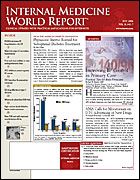Publication
Article
Internal Medicine World Report
Look for the Subtle Features of Nutritional Deficiency
Author(s):
From the Mayo Clinic's Advances and Controversies in Clinical Nutrition
Skin, Hair, or Nail Changes Can Be Clues to the Diagnosis
KEY BISCAYNE, Fla—Nutritional deficiency may not be immediately obvious when a patient presents to your office, so it is important to recognize the signs and symptoms often associated with it, such as unusual skin, hair, or nail changes, said Marcus Ferrone, PharmD, of the Mayo Clinic and St. Luke’s Hospital, Jacksonville, Fla, in his discussion of vitamin and mineral deficiencies at the Mayo Clinic’s 16th Annual Advances and Controversies in Clinical Nutrition Seminar.
Dr Ferrone focused on 3 patient groups who, for various reasons, were unable to take or hold down vitamins or supplements, such as thiamine, zinc, or pyridoxine. One common denominator in these cases was inadequate dietary supplementation, which in turn led to their clinical symptoms.
Usually a deficiency results from an imbalance between what is nutritionally required and what is actually provided. Needs may increase by a loss of nutrients in conditions such as fistula, high stool output, or drains—losses that adequate supplementation cannot compensate for. More common conditions that often affect the elderly involve involuntary weight loss and different hormonal problems.
“Any type of imbalance is usually due to what the patient actually needs and is not being provided.?And most of these are not measured directly,” Dr Ferrone says. “We look at clinical signs and symptoms and must determine the cause for the patient’s complaints.?If there is a possible dietary cause, clinicians have to decide if the deficiency is due to inadequate intake or defective utilization once in the body.?Often, proper supplementation of those suspect micronutrient deficiencies corrects the problem.”
Nutritional deficiencies are unlikely to occur in patients using a medically approved diet who follow nutritional guidelines and are monitored by a physician on a regular basis or when there is a radical change in diet, regardless of cause.
IMWR
“Nutritional deficiency is not something that we routinely test for,” Dr Ferrone told . “It’s often just [diagnosed during] presentation at the physician’s office. Usually, patients say that they are developing some sort of rash, or having some sort of muscle weakness, or something like that. But we normally try to catch that ahead of time,” he said.
Patients who have routine appointments to see a physician or a dietitian can keep track of what they eat so that “they don’t develop a deficiency in micronutrients or vitamins.”
Physicians, Dr Ferrone says, should look for certain dermatologic, neurologic, and cardiovascular/metabolic signs and symptoms whenever they are radically altering a patient’s diet—be it a parenteral, enteral, or just a regular diet—or if they practice in an area where their patients may not be consuming a balanced diet.
“Look for the possible etiologiethrough their medications and disease process,” he noted. Certain diet-related signs are helpful in recognizing the medical problem. “You can always go back and consider ths of those symptoms and consider nutrient deficiencies. Often they are not nutrient related, but it is always something we should be aware of after we’ve scanned at perhaps it’s their diet that may be a potential etiology for whatever signs or symptoms they may be experiencing,” he added.
Look for certain dermatologic, neurologic, and cardiovascular/metabolic signs.





